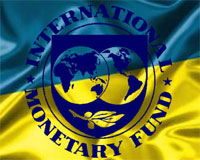Aimed at Total Destabilization
By Ernst Wolff

On February 12, Christine Lagarde,
Managing Director of the International Monetary Fund, announced that the
IMF had reached an agreement with the Ukrainian government on a new
economic reform program. Ms Lagarde’s statement, made in Brussels, came
only minutes after peace negotiations between the heads of the German,
French, Russian und Ukrainian governments in Minsk, Belarus, had ended.
The timing was no coincidence. Washington had been left out of the
negotiations and now reacted by sending its most powerful financial
organization to the forefront in order to deliver a clear message to the
world: that the US will not loosen its grip on the Ukraine, if not by
sending weapons, then at least economically and financially.
Mme Lagarde’s assertions that the
program „would support immediate economic stabilization“ and spell „a
turning point for the Ukraine“ are as far removed from reality as the
main stream media’s depiction of the IMF as an aid organization helping a
drowning country to survive in times of trouble. Not a single cent of
the loans will go to the Ukrainian working people. Instead, the money
will be used to prop up the Yatseniuk government which is totally
subservient to US interests, and enable it to service the debts incurred
by its predecessors in the aftermath of the financial crisis of 2008,
to pay off most of its military expenses of around $ 250 million per
month for the continuation of a war against its own population and to
fill at least some holes in the state budget which are due to the
country’s ongoing economic deterioration.
The loans will be based on the terms of
an economic program for Ukraine for 2015 – 2020, passed by the Kiev
parliament in December 2014, and are tied to harsh conditions laid down
in a letter of intent, signed by prime minister Yatseniuk and president
Poroshenko in August 2014. Some of the measures have already been
implemented, others will follow. Among those already in force is the
flexible exchange rate regime which has not only led to a 67%
devaluation of the hrivna, lowering the average monthly wage of
Ukrainian workers to less than $ 60, but has also opened the doors for
international currency speculators who have already made millions by
indebting themselves in hrivnia and repaying their debts in euros and
dollars.
The rate of inflation, running at 25 %
in 2014 and expected to rise even higher in 2015, and a hike in gas
prices by 50 % in May 2014 made survival almost impossible for the
weakest 20 % of the population who already lived below the poverty line
in 2013. Among the measures still to come are the layoff of 10 % of the
country’s public employees and the partial privatization of health care
and education. The retirement age for women is to be raised by 10 years,
that for men by 5 years, most benefits for old age pensioners are to be
abolished, the pharmaceuticals market is to be deregulated. Retirement
pensions will be frozen, and there will be no more free lunches for
school children and patients in hospitals. Benefits for victims of the
1986 nuclear disaster in Chernobyl are to be cut, and the boundaries of
the officially designated radioactive hazard zone will be revised. The
country’s monthly minimum wage is to remain at 1,218.00 hrivna ($ 46 at
the current rate of exchange) until at least November 2015.
None of these measures will serve to
„improve the living standards for the Ukrainian people“, as cynically
predicted by Ms Lagarde. Nor will they „restore robust growth“ in an
economy which is teetering on the verge of collapse, with a central bank
left with only $ 6 billion in currency reserves and incapable of
raising new fundi

ng in foreign exchange auctions.
However, they will contribute to an intensification of the suffering of
the Ukrainian people, deepen the social divide of a country already torn
apart by a bloody civil war and lead to its complete disintegration,
nurturing separatist movements and thus creating perfect conditions for a
future of violence and despair.
In pursuing this strategy, the IMF is
totally in line with the geopolitical policies pursued by Wall Street
and the government in Washington. Both are in deep trouble, with the US
torn apart by ever-increasing social inequality threatening to explode
in massive social unrest, while its rulers are drowning in debt and
losing control over the world financial system. Having dominated global
markets for seven decades, the United States’ economic decline and a
shift in global power are ringing in the end of the US dollar as the
world’s reserve currency and thereby heralding the end of the US’s
status as the world’s super power.
In a reckless attempt to stop this
unstoppable process, Wall Street and the White House are waging an
extremely aggressive campaign against Russia and China who have dared to
complete an energy deal outside the petro-dollar and whom the US fear
to be preparing a new, possibly gold-backed, currency that might replace
the US dollar as the world’s reserve currency. To prevent this from
happening and to gain control of the vast natural riches of Russia which
promise enormous profits, Wall Street and the White House are pursuing a
strategy of regime change in Moscow, undertaking everything possible to
replace the Russian government by one that is as subservient to US
interests as that of Ukrainian premier Yatseniuk and his investment
banker cronies in Kiev.One of the means to this end is the integration
of Ukraine into NATO in order to step up the military threat against
Russia. However, as the EU – and Germany in particular – do not seem to
be willing to join forces in an all-out war against Russia (not out of
humanitarian considerations, but because of their dependency on Russian
gas and oil and their anticipation of a new monetary world order no
longer dominated by the US) and as the majority of Americans, despite a
massive media campaign demonizing Vladimir Putin, are unwilling to
support a war that would cost more money and more lives than any war in
the past and could end up in a nuclear catastrophe, the US government’s
and the IMF’s main purpose in Ukraine is to deepen and widen the already
existing economic, social and ethnic conflicts. By doing so, they hope
to force Vladimir Putin into a long-lasting and costly war that will
weaken his position at home and eventually pave the way for the
installation of new rulers in Moscow.
Looking at Ukraine as a part of the
present geopolitical struggle, one can see that the IMF’s new loans to
Ukraine, announced by Christine Lagarde, are anything but a „turning
point“ signalling the country’s stabilization. They will lead to
unspeakable human suffering and contribute to the trail of blood which
Ms Lagarde and the IMF are so used to leaving behind after intervening
under the pretext of „helping“ countries in times of trouble.
No hay comentarios:
Publicar un comentario